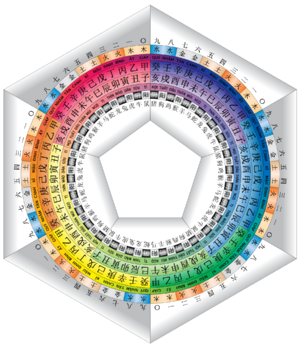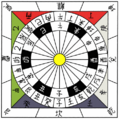Sexagenary cycle facts for kids
The sexagenary cycle (六十花甲 liùshí huājiǎ), also called the "stems-and-branches" (干支 gānzhī), is an old Chinese calendar system. It uses a list of sixty special terms to name days or years. Think of it like a unique way to count time in a repeating pattern.
Contents
History of the Cycle
The Chinese have used this system for a very long time to keep track of dates. It's one of their oldest ways to organize time.
Ancient records show that people were using the sexagenary cycle to count years as far back as the 3rd century B.C. That's over 2,300 years ago!
This repeating cycle of 60 terms became very important in many East Asian countries. These include China, Japan, Korea, Tibet, and Vietnam.
How the Cycle Works
Each term in the sexagenary cycle is made from two different Chinese characters. It's like combining two lists to make 60 unique names for a period of time.
- One character comes from a list called "heavenly stems" (天干 tiāngān). These are linked to five natural elements: wood, fire, earth, metal, and water.
- The other character comes from a list called "earthly branches" (地支 dìzhī). These are often linked to the twelve animal signs. These animals include the Rat, Ox, Tiger, Rabbit, Dragon, Snake, Horse, Goat, Monkey, Rooster, Dog, and Pig.
- When you combine these two lists, you get a total of 60 different names. Each name stands for a specific year or day in the cycle.
Heavenly Stems Explained
There are ten "heavenly stems." Each stem is connected to one of the five elements and also to either yin or yang. Yin and yang are ancient Chinese ideas about opposite but connected forces.
| No. | Heavenly Stem |
Chinese name |
Yin Yang | Element |
|---|---|---|---|---|
| 1 | 甲 | jiǎ | Yang | Wood |
| 2 | 乙 | yǐ | Yin | |
| 3 | 丙 | bǐng | Yang | Fire |
| 4 | 丁 | dīng | Yin | |
| 5 | 戊 | wù | Yang | Earth |
| 6 | 己 | jǐ | Yin | |
| 7 | 庚 | gēng | Yang | Metal |
| 8 | 辛 | xīn | Yin | |
| 9 | 壬 | rén | Yang | Water |
| 10 | 癸 | guǐ | Yin |
Earthly Branches Explained
There are twelve "earthly branches." Each branch is linked to one of the twelve animals of the Chinese Zodiac. They also represent specific hours of the day.
| No. | Earthly Branch |
Chinese name |
Chinese Zodiac Animal |
Corresponding Hours |
|---|---|---|---|---|
| 1 | 子 | zǐ | Rat (鼠) | 11 p.m. to 1 a.m. |
| 2 | 丑 | chǒu | Cow (牛) | 1 to 3 a.m. |
| 3 | 寅 | yín | Tiger (虎) | 3 to 5 a.m. |
| 4 | 卯 | mǎo | Rabbit (兔) | 5 to 7 a.m. |
| 5 | 辰 | chén | Dragon (龍) | 7 to 9 a.m. |
| 6 | 巳 | sì | Snake (蛇) | 9 to 11 a.m. |
| 7 | 午 | wǔ | Horse (馬) | 11 a.m. to 1 p.m. |
| 8 | 未 | wèi | Goat (羊) | 1 to 3 p.m. |
| 9 | 申 | shēn | Monkey (猴) | 3 to 5 p.m. |
| 10 | 酉 | yǒu | Chicken (雞) | 5 to 7 p.m. |
| 11 | 戌 | xū | Dog (狗) | 7 to 9 p.m. |
| 12 | 亥 | hài | Pig (豬) | 9 to 11 p.m. |
Related pages
Images for kids
See also
 In Spanish: Ciclo sexagenario para niños
In Spanish: Ciclo sexagenario para niños





